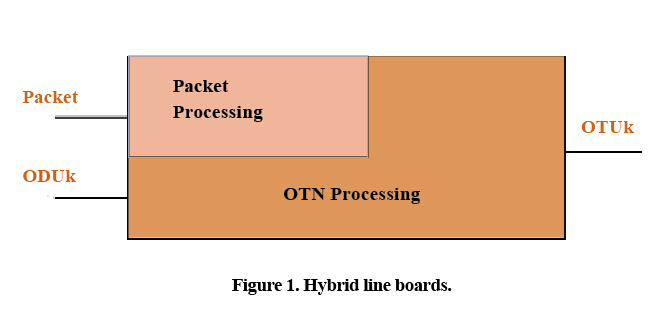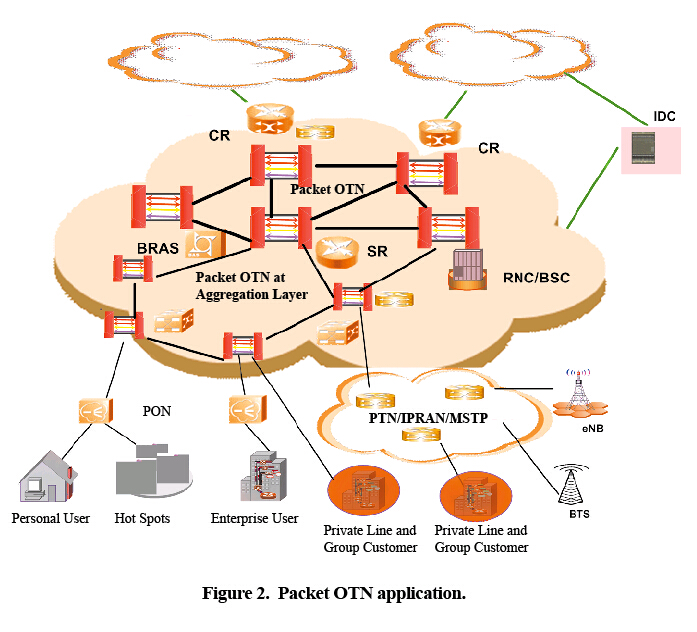Packet OTN for Efficient Bearing
Rapid growth of bandwidth and IP transformation of services have been the two main drivers of network development. The emergence and development of high-bandwidth data services has caused the transport network to evolve from TDM to WDM; from 2.5G and 10G to 100G; and from VC to ODUk switching. By combining the advantages of SDH and WDM, OTN provides huge bandwidth; quick, flexible service scheduling; and complete OAM functions. In the era of huge bandwidth, OTN has become the basic transport platform for multi-service. It has been widely deployed in trunk line networks and at the metro core network and aggregation layer. As large-bandwidth OLT fades away and large-granularity private line service emerges, compact OTN is being deployed at the access layer. IP transformation of services has meant that the focus of OTN bearing is packet services. OTN mainly carries interconnection services between routers, OLT uplink services of the fixed-line broadband network, and large-granularity private-line packet services. The physical interfaces of these services are Ethernet of various rates. Efficient bearing of packet services is the new hot topic in OTN.
Operators have to invest in their networks in order to increase bandwidth; however, revenue from large bandwidth services is declining. This problem is plaguing operators. A key concern of operators is how to efficiently use network bandwidth to handle large volumes of traffic and increase the intelligence of channels.
As the basic platform of the transport network, traditional OTN provides a rigid channel that carries packet services that may not occupy all the bandwidth. This is inefficient. Packet OTN optimizes packet transport, provides some new packet functions in OTN, and increases efficiency across the whole bearer network. It packet services with high port bandwidth utilization ensures efficient pass-through in fixed-line broadband uplink. Packet services with low bandwidth utilization can improve bearing efficiency by adopting statistical multiplexing. Expensive core routers are overburdened by huge bandwidth, and most services are only forwarded. However, these services can be bypassed at the optical layer to improve overall efficiency. With the development of mobile internet, the rise of the content providers, and the emergence of virtual network operators, high value-added private line services have gradually become important revenue sources for operators. Bearing private lines in OTN can simplify the network layer and speed up service provisioning time. This helps an operator stay ahead of the competition.
There is a consensus within the telecom industry about the benefits of enhanced packet service in OTN, and mainstream equipment providers have already released OTN pocket equipment for all parts of the network.
Packet OTN
There are two types of packet implementation in OTN: 1) adding a service card that supports packet switching and processing to the existing OTN equipment, and 2) providing a centralized packet switching plane in OTN. With the former, the packet switching matrix is built on the traffic board so that the matrix can only be implemented on the board. With the latter, packet switching between cross-service boards is made more flexible.
A board-level packet OTN may have separate branch lines or integrated branch lines. With separate branch lines, packet services can be encapsulated into ODUk or ODUflex upon completion of packet processing and switching. Packet services then enter the OTN cross-connect matrix. With integrated branch lines, packet services can be encapsulated into OTUk upon completion of packet processing. Packet services are then transmitted through the line.
Board-level packet OTN with separate branch lines is used in compact OTN equipment and is widely applied at the aggregation and access layers in metro areas. This enables flexibility through OTN cross-connect, and it also enables smooth upgrading. Packet boards can easily be added to OTN equipment in the existing network. Packet OTN strikes a balance between increased packet flexibility and protecting investment in the existing network.
The existing OTN can be upgraded to packet OTN by taking a dual-plane approach, which involves two independent cross-connect matrixes for one device. This increases cost and power consumption, and cross-connect boards need to be replaced. Therefore, universal cell switching is the mainstream technology for implementing packet OTN. All of the standout OTN products from equipment providers are based on universal cell switching. Universal cell switching is also defined in ODUk over packet fabric (OPF) protocol of OIF. The core of this technology is a universal cell-switching matrix. Services such as ODUk and packets are sliced into cells on the traffic boards. These cells enter the universal cell-switching matrix, get switched to line side boards, are encapsulated into OTUk, and are transmitted through the line. With OPF, OTN equipment can more flexibly switch large-capacity packet services and can switch services of any size from packet to OTN.
Hybrid line boards for both packet and OTN processing are used in the packet OTN application (Fig. 1). Packet service and OTN service are aggregated on one line board for hybrid transmission. This significantly improves OTN bandwidth utilization, reduces line-side board types, and simplifies OAM.

Packet OTN Applications
Packet OTN can be implemented in any scenario where traditional OTN is used (Fig. 2). When packet OTN is deployed in the network, an operator can select service bearing or transport mode depending on service needs. At the backbone core layer, OTN pass-through or OTN packet processing can be selected according to the router load to bypass traffic for router interconnection services. At the core and aggregation layers, OTN pass-through or OTN packet processing can be selected according to broadband network traffic so that bandwidth is converged and ports are converted. For private line service, OTN pass-through or OTN packet processing can be selected according to service level, service granularity, or bandwidth utilization. For mobile backhaul service, OTN pass-through or OTN packet can be used to ensure interoperability with PTN, IPRAN, and MSTP in the existing network. This guarantees good end-to-end service performance.

As the basic platform of the transport network, the main function of OTN is to bear multiple services. By introducing packet processing into OTN, packet services can be processed more flexibly and efficiently, and efficiency can be increased across the whole network.
Evolution and Deployment of Packet OTN
Different packet OTN technologies have their own pros and cons in a newly built network or in an evolved existing network.
A large amount of OTN equipment based on timeslot cross-connect has been deployed in existing networks. Such equipment can easily support OTN functions through the addition of packet boards to the OTN in the existing network. This upgrade is an efficient way of supporting router bypass and broadband uplink. In a newly built OTN network, OTN equipment with universal cell switching can be used. If packet OTN is needed in the future, packet boards or hybrid line boards can be added so that the network supports various packet application scenarios.
At the backbone core layer in a newly built packet OTN, packet OTN equipment with universal cell switching can be used for large-capacity packet processing. At the edge access layer, board-level compact packet OTN equipment can be used to provide low-cost, energy-efficient solutions.